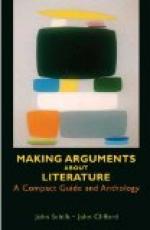Reasoning from circumstantial evidence differs from reasoning from analogy or generalization in that it rests on similarities reaching out in a number of separate directions, all of which, however, converge on the case in hand. This convergence is pointed out by Macaulay in the following admirable little argument on the authorship of the Junius Letters, which were a series of pseudonymous and malignant attacks on the British government about 1770:
Was he [Francis] the author of the Letters of Junius? Our own firm belief is that he was. The evidence is, we think, such as would support a verdict in a civil, nay, in a criminal proceeding. The handwriting of Junius is the very peculiar handwriting of Francis, slightly disguised. As to the position, pursuits, and connections of Junius, the following are the most important facts which can be considered as clearly proved: first, that he was acquainted with the technical forms of the secretary of state’s office; secondly, that he was intimately acquainted with the business of the war office; thirdly, that he, during the year 1770, attended debates in the House of Lords, and look notes of speeches, particularly of the speeches of Lord Chatham; fourthly, that he bitterly resented the appointment of Mr. Chamier to the place of deputy secretary-at-war; fifthly, that he was bound by some strong tie to the first Lord Holland. Now, Francis passed some years in the secretary of state’s office. He was subsequently chief clerk of the war office. He repeatedly mentioned that he had himself, in 1770, heard speeches of Lord Chatham; and some of these speeches were actually printed from his notes. He resigned his clerkship at the war office from resentment at the appointment of Mr. Chamier. It was by Lord Holland that he was first introduced into the public service. Now, here are five marks all of which ought to be found in Junius. They are all five found in Francis. We do not believe that more than two of them can be found in any other person whatever. If this agreement does not settle the question, there is an end of all reasoning on circumstantial evidence.[46]
Here the five points or marks of similarity between the writer of the letters and Philip Francis are of such diversity that it would be an extraordinary coincidence if there had happened to be two men whom they would fit: where so many lines converge so closely at a single point it would hardly be possible for them to meet on more than one person.
The following brief extract from Webster’s argument in the White Murder Case shows the same sort of convergence of similarities: each circumstance in itself is hardly strong enough to furnish ground for an argument on analogy, but taken all together they point irresistibly in one direction, namely, to the fact of a conspiracy.




